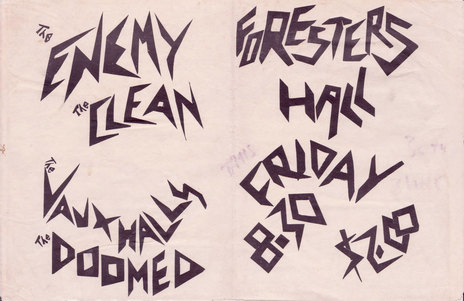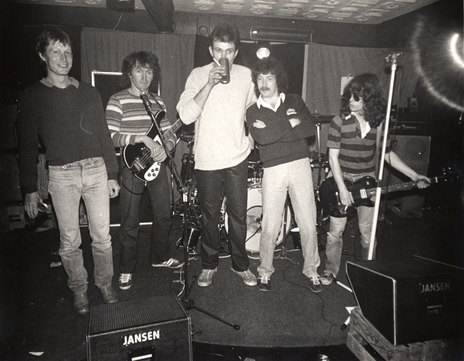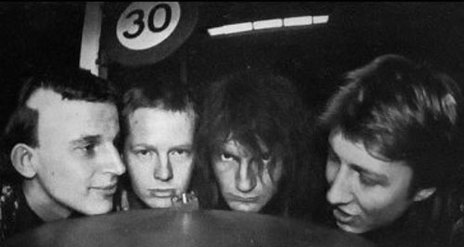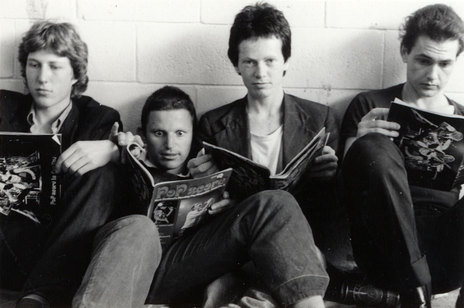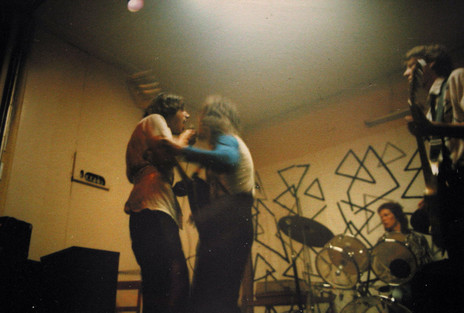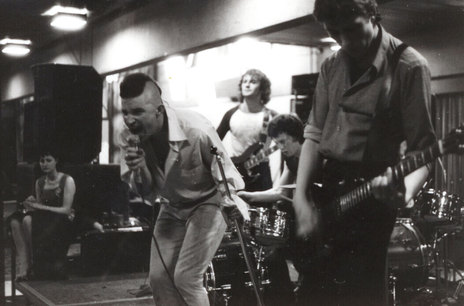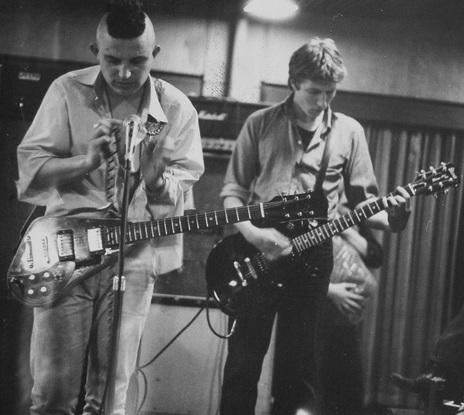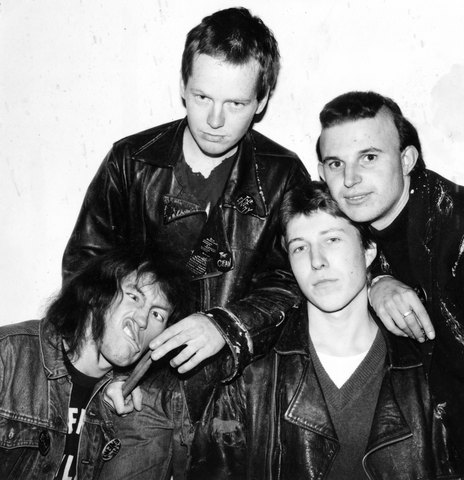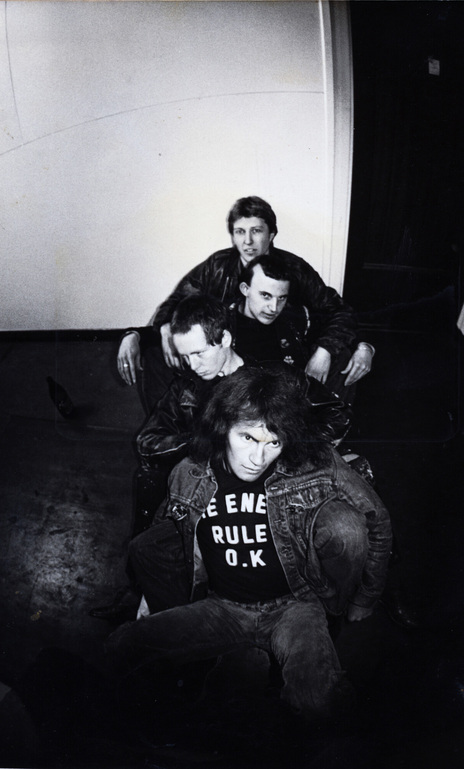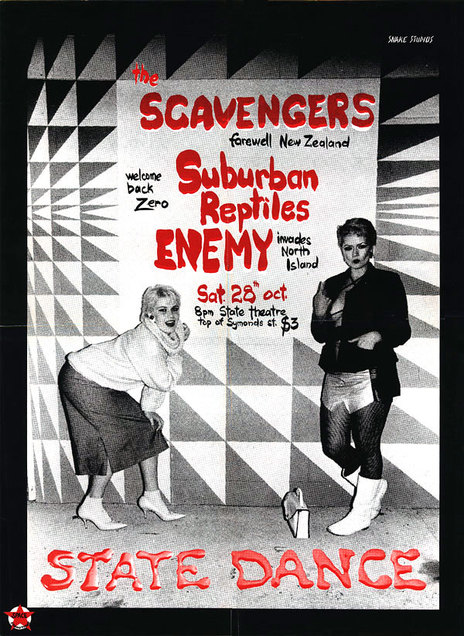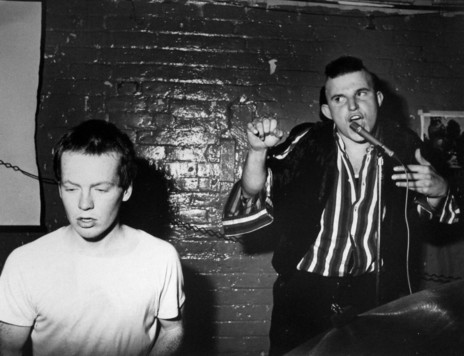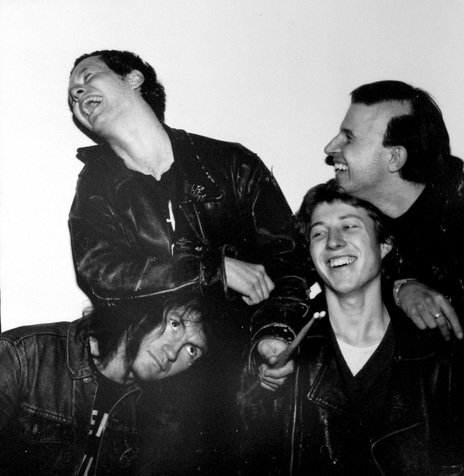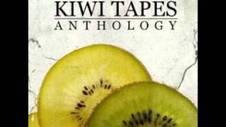As early as mid-May 1978 and only six months after their first show, Colbert was coupling The Beatles and this time the Sex Pistols as key motivators for The Enemy in his burgeoning narrative of the Dunedin group.
“It was something we could relate to,” Chris Knox said in 1991, explaining punk’s appeal to Wendy Yee in Christchurch fanzine, Kahoutek. “Because we were sick to death of all the same things that English punks were sick of – you know, the ‘muso’ scene, the powers that be, the ‘system’, etc.
“It was very much like the hippie thing from the 1960s, but attacked from a different angle and much more attacked, rather than sort of, ‘slid away’ from, like the hippies tended to. So yeah, it was the right thing at the right time. What more could you ask for, really?”
Lifelong fan, friend, and later roadie and lighting man Chris Moody, who by 1976 was flatting with Knox and the group’s organiser and soundman-to-be Doug Hood in Dunedin’s Filleul Street, admitted in a revealing interview with Roy Colbert in The NZ Listener (“Know Your Enemy” April 2005) to having quick access to information about the British and American scenes.
Knox was tending a record store counter dressed in a ratty three quarter length fur coat and shorts, having spent the morning as a postie.
His parents owned a bookshop in Mosgiel, just over the southern hills from Dunedin, where Moody received airmail copies of Rolling Stone, Creem and NME. It’s doubtful that in such a music-mad flat, the three key music texts of their time were read by one pair of eyes alone.
On the day The Enemy met, the “larger than life, charismatic and very friendly” Knox was tending a record store counter dressed in a ratty three-quarter length fur coat and shorts, having spent the morning as a postie.
With the older Knox, an admitted pre-teen and teen Beatles fan, and the younger Alec Bathgate and Mike Dooley closer to Generation X (children born after 1961), the trio were on the cusp of the old and new, and aware of both. Prior to meeting Knox, Bathgate and Dooley had advertised for a “bassist into Velvet Underground”.
Knox informed Bathgate and Dooley that he was a vocalist and had a band. For the next few practices, Knox faked it on the bass, before they all gave in and drafted Dawson.
There was a reason for haste. The Enemy had a show booked for 16 November 1977, an anti-disco dance organised by Otago Polytechnic in the old Beneficiaries Hall just across the road from Knox’s flat.
Roy Colbert, writing as Double Track in the Evening Star’s Top Pops column, saw the new group’s early light and noted the impressive swag of originals on display. ‘Iggy Told Me’, ‘Lou Reed’ (who played Dunedin as recently as 23 October 1977), ‘We Are The Enemy’, ‘I Wanna Die With You’, ‘ Government Health Warning’, ‘Farrah Fawcett-Majors’, ‘I Just Can’t Get It Up’, ‘Lady of Soul’, ‘Jack Crap’, and ‘Rainbow’ were among the 20 or so new songs performed.
Colbert noted the quality of The Enemy’s songs in contrast to what was being heard from the UK and United States. The power of the group’s performance also drew comment. “The Enemy provided more visual and physical fun than most of the jumping, shouting crowd could handle.”
Alec Bathgate described Knox’s onstage presence to Scott Kara at New Zealand Herald (November 2012). “Chris had grown a beard and grown his hair long and he said he was going to do something but we didn’t know what. And on the night, he shaved one half of the beard off and cut one half of his hair really short. He’d never tell you what he was going to do and often it was spontaneous, like wrapping his head in tape or tin foil.”
The songs, the confrontational show, Knox the front man with the ever-changing look, it was all there at the show.
The Enemy’s next appearance was at Red Octopus in late 1977 followed by their first pub date at Gardens Tavern in January 1978, and two more at the Captain Cook in early February. The Enemy played both University of Otago and Otago Polytechnic orientation shows that month.
In March, they began the series of weekend shows in their Dowling Street practice rooms, which ran right through until August 1978.
Mike Dooley (Spec, mid-1990s): “The Enemy early on at practice had people turning up all the time, Peter Gutteridge and members of The Clean were there a lot. Our gigs were events, not performances. Everyone participated – other bands and the audience – I used to let people get up and play on my drum kit – they really were anarchic events sustained by the momentum – at some point we forgot this aspect and a rift appeared (to me) between the band and the audience.”
The enduring Enemy classic ‘Green Walls’ is a tribute to their Dowling Street practice room and was often performed as a prelude to the storming ‘Swimming Pool’.
Who else was in the audience? Knox to Wendy Yee (Kahoutek, 1991). “In Dunedin, there weren’t any punks, there were just people who went along to these gigs. Because down in Dunedin, there was already a sort of vague counterculture, and bands like The Enemy and The Clean gave it a bit of focus. But it never really became a real punky thing. The idea of becoming a punk was pretty well sneered upon.
“And the South Dunedin scene was, yeah, V8 boys, bodgies, surfies and they were the sort of people, who prior to me being in The Enemy, would’ve dearly loved to have me beaten up most times.
“Once they saw The Enemy, they had a grudging respect for the noise we were making, and the attitude we displayed. And didn’t become our friends, but let us go to places they went without beating us up, which was quite nice.
“But generally it was a scene I detested. There were only two surfies I knew that I could stand, and they were David and Hamish from The Clean, and they surfed at different places, they didn’t surf with the other surfies.”
Mike Dooley credits Hamish Kilgour for The Enemy’s name. It’s also a verbal take on NME, the abbreviated title of the British music weekly, New Musical Express.
There were yet more shows in March 1978 at the Cellar and Captain Cook. In April The Enemy headed to South Dunedin Town Hall for a dance before taking the highway north to Christchurch to link up with emerging punk groups The Aliens, The Doomed and Johnny Velox and The Vauxhalls at University of Canterbury and punk-friendly all-age venue, Mollett Street.
The Christchurch and Dunedin punk scenes were clearly aware of each other. In time, key Christchurch figures Tony Peake and Roger Shepherd ventured south to check out The Enemy on their home turf.
The Enemy returned to the old Beneficiaries Hall on 11 May with The Clean and London SS. Two consecutive nights at Captain Cook followed. The Vauxhalls reciprocated The Enemy’s Christchurch visit with another night at the Beneficiaries Hall on 2 June, followed by a practice room gig on 4 June.
The Enemy returned to the Christchurch for dates at Forresters Hall on Oxford Terrace on 30 June and Mollett Street on 2 July with The Vauxhalls, The Doomed and The Basketcases, (featuring future Toy Love members Paul Kean and Jane Walker).
Earlier that morning at 6am The Enemy knocked out a powerful live version of ‘Swimming Pool’ for the weekend-long televised charity event Telethon.
The word spread nationwide. When the bill assembled for the New Wave Special ’78, an event on 18 June showcasing punk groups from Auckland and Wellington, the organisers regret they couldn’t include The Aliens and The Enemy because of cost.
In mid-July, The Enemy headed to Knox’s hometown, Invercargill, for the first of several shows at Don Street. August saw more practice room shows, often featuring new songs from the prolific group and the Kaikorai Valley High School performance, later described by Shayne Carter as a light bulb moment.
With new songs piling up and the South Island’s emerging punk community already tended to, The Enemy changed gear in September. The Vauxhalls joined them and Mick Dawson’s second group Heavenly Bodies at the Coronation Hall show in Dunedin on 2 September.
They were back in Invercargill on 7 September, where they played a storming version of a new song from The Clean, ‘I’m In Love With These Times’. The following day, the Dowling Street practice room was the set for a shagged out Enemy being captured on film, from which the clip for ‘Iggy Told Me’ is plucked.
In mid-September, The Enemy jammed into Doug Hood and Chris Moody’s matching matte black vans, which were stuffed with their equipment and 17 dozen bottles of their local brew, Speights – and headed for Auckland arriving on the 19th or 20th.
Auckland was the biggest punk market with venues such as Zwines, Windsor Castle, HQ Rock Café, Occidental, State Theatre and the University of Auckland Cafe all willing to host the renegade sound. There was also the added lure of the city’s recording studios and the hope of a record deal.
The Dunedin punks found their look was starkly at odds with that of the Queen city’s pioneer and second-wave punks. But that mattered little after The Enemy unleashed a ferocious performance in front of over 400 fans at the University of Auckland Café on 22 September, a night shared with Auckland’s best: The Scavengers, The Rednecks and Sheerlux.
Knox’s party trick of slashing his body with glass a la Iggy Pop was soon in evidence. Bathgate to Scott Kara (NZ Herald, November 2012): “Early on, when Chris was cutting himself I really liked him doing that because I liked watching the reaction of the audience. We didn’t want to be this passive band on stage, we wanted people to be really affected when they saw us play.”
The Enemy were onstage at The Windsor and Zwines the next day with The Scavengers and The Atrocities. They returned to backstreet punk dive Zwines a week later, then set out for the unlikely punk destination, Mount Maunganui, a surf resort near Tauranga on the North Island’s east coast.
Billed as the “South Island’s Top New Wavers”, the South Island took apart the Mount Maunganui Sports Stadium on 30 September before shifting to QE II Youth Centre on 1 October. Band members remember a third spot at a beach hall, attended by the local bikie gang.
October was jammed solid with Enemy shows. The Dunedin punks joined The Scavengers at the Windsor Castle and Zwines from 6 to 8 October, picking up Rooter for the late evening shows. There were two mid-week nights at The Gluepot, two more nights at Windsor Castle, then the same at HQ Rock Café, before an evening at the State Theatre with The Scavengers on 28 October. (The Suburban Reptiles had been advertised but had split by then.)
The three songs captured were never issued as a single as intended, which is more than a pity.
The Enemy put down their first properly recorded studio tracks at Mascot in October. The three songs captured were never issued as a single as intended, which is more than a pity. They would have made a startling debut single. ‘Swimming Pool’, had it been released at the time, is the vital musical link to early 1980s The Clean and the successive Flying Nun groups that is otherwise only hinted at. ‘Green Walls’ has a bite sharper than later versions although the muddy recording of ‘Pull Down The Shades’ is an ugly duckling.
It was all going well. Too well. Mick Dawson became homesick. There were a few more nights at Zwines with Johnny and the Hookers and Windsor Castle afternoons with The Rednecks and Idle Idols before Dawson left the McKelvie Street house.
Before he went, The Enemy recorded their set at Harlequin Studios. It was a strong batch. ‘Don’t Catch Fire’ is almost Pebbles folk rock. ‘Lust’ has a Stooges-inspired riff and kick. ‘I Don’t Mind’ is a huge rumbling demolition of the skittery track that ended up on Toy Love, and a major improvement. ‘Frogs’ is demented, the most menacing and free-for-all of three recorded versions. ‘Iggy Told Me’ is a ranting, sprawling epic hinting at The Enemy’s early live power. ‘Gone To The Worms,’ Rainbow ‘and ‘Can’t Get It Up,’ are on the tape as well.
After a brief time with the post-Split Enz, pre-Swingers Phil Judd onboard, The Enemy morphed into Toy Love with the addition of Paul Kean and Jane Walker, late of The Basketcases.
Kean to Scott Kara (NZ Herald, November 2012). “Chris had this menacing look, not menacing as in scary, but dramatic. And in behind it, there were some really great songs. Mick Dawson playing fantastic bass lines, Mike Dooley doing his distinctive rolling style of almost tribal drumming, and then, of course, Alec on his Ibanez 59er.”
It was only a year since The Enemy first formed. The South Island fell quickly. “Zwines, Rooter, boot boys and butch slags, ODs and knifings, the big smoke had its moments,” Knox wrote of the Auckland stretch in national newspaper Sunday Star Times on 17 April 2005.
For Mike Dooley it was more of an ordeal. “That whole period in Auckland was really bleak – basically a period of starvation – one of several. At times I’ve thought The Enemy were a better band than Toy Love. Why? In terms of playing cohesively as a whole unit. Toy Love had too many individuals with their own opinions and directions whereas The Enemy was like some machine/beast/hybrid that couldn’t be stopped once it got going.” (Spec, mid-1990s).

